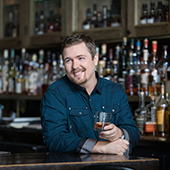When I first started working in the hospitality industry, I was given a manual and the trainer never opened it once. The person who trained me wasn’t even certified. She was just someone that the manager instructed and said to me, “Andrew is going to shadow you for the day” and she looked at me, looked at the manager, back at me and said, “Don’t get in my way”.
With a giant *gulp*, I shadowed her and simply watched as she worked - for the whole eight hours. When it was my turn to be a server, I was making mistakes left and right. My manager pulled me aside and asked why I was making these simple mistakes. I told them that’s what I observed, and that's what was being shown to me.
Although I didn’t know it at the time, that was my first lesson in creating a training program.
The real question is, how do you create an effective training plan for your restaurant? (that won’t be a forgotten document gathering dust)

Focus on the purpose of your training program
Imagine opening four restaurants, and you’re in charge as the Director of Training (with little experience at the time). This was the position I was put in, thinking I knew the ins and outs of training programs.
Then when I started putting together a manual, the Director of Operations asked me, “What is a training program designed to do?”
My answer was that training was essentially a way to get someone up to speed and onto the schedule.
He looked at me square in the eyes and said, “What is a training program designed to do, really?”
Stumped, I tossed out a few other answers and he said, “That’s what most people think, but that’s not correct. Training programs are designed to see if your potential employees can meet your standards.”
That was the key to all of my frustrations when I was working as a restaurant manager. My General Manager would just train people or would have trainers teach staff and throw them on the schedule once they went through the standard training period. But that’s where most restaurants get it wrong.
Training programs shouldn’t be designed to get people onto a schedule. It’s a qualification period to see if the people you hired can handle stress, fit into the culture and organization, or simply see if they can rise to meet your standards.
With this in mind it makes it easier to map out the rest of your training program, determine which employees are the right fit and understand that training is a long term nurturing process.
Learn about how to create a great training program in this online course at typsy.com

Start somewhere
The best thing that you can do for your employees is to simply start somewhere. Most restaurants, when they first open up, have a 1-2 sheet document with their mission statement, their values (if any) and any service standards. This is basically a quick 30,000ft birds-eye view of a training program.
This type of training is from someone who has never opened up a restaurant before, and overlooked it until the very end when they realized that people don’t just learn from on-the-job-training.
Having something though is better than nothing, so if you don’t have anything, start with your service standards. This will allow you to provide yourself with a base for your training. Start here, because if you think that you need a 100-page training manual for every position, you’ll never open the doors.
Ensure your training program is inclusive
Here is where my love of learning and how adults learn come into play. Remember that children and adults learn differently and the reason behind that is most adults come with pre-existing notions of how things are done, especially if your (adult) employees have previously worked at other restaurants.
Your employees know how to serve. They know how to chop veggies. They know how to prepare a well-done steak. They even know how to rotate between sections if they were a host.
However, what if you hire someone without experience but they have an amazing attitude? Your training program needs to accompany their needs and it cannot simply be done from on-the-job training or shadowing. Training needs to be welcoming to everyone from all backgrounds and all learning styles.
Use mixed learning styles in your training program
An effective training program has both passive learning and active learning. Passive learning is around:
- Reading
- Lectures
- Watching online trainings or demonstrations
The other half of the training is active learning. These focus more on:
- Participating in discussions
- Actually doing the training
- Training someone else
Another focus area of training, is the different learning styles of every employee. They usually fall into the following categories:
- Visual learners
- Auditory learners
- Kinesthetic learners
Keeping these in mind will ensure that your training program is dynamic, and more applicable to what a typical service could look like at your restaurant.
Show employees the right way
The biggest mistake that most trainers make in their training program is that they spend more time talking to the trainee about what not to do instead of focusing on what the trainee should be doing.
I learned this from my Director of Operations when I was leading a training session. Mid-rush, he pulls the training team aside and says,
“I get what you are doing but people don’t learn through negatives. If you tell them not to do something and then show them how to do it the right way, they’ll only see what not to do. Show them what we always do and watch how things shift”.
The subconscious mind doesn’t process negatives. So when you tell someone not to do something, the subconscious mind only hears that you should be doing it and creates the habit of doing something incorrectly.
When writing training manuals...
Now that we have the nuts and bolts behind training, creating effective training manuals comes next. The training manuals must have an overview of how long the training is, what the trainees will be doing every single day and then break down each step into detail.
The principles behind having correct training manuals is that staff can take it home and read it to remember what they learned that day. It’s a retention process and exercise.
The training manuals should always be a step-by-step walk through of everything they will learn until the end of the training period. For example, if there’s a certain way to set-up each table, put a photo in the manual about how the tables should be reset every single time.
When creating these training manuals, think about how you can get trainees up to speed as quickly as possible, while having an amazing learning experience. It’s important to take the time and go step-by-step for each position.
What needs to be learned and how can you take someone with little, or with some experience, become a restaurant rockstar?
Then list out everything. Here’s an example:
As a server, what’s the first thing that we need to learn? Make a list! Here are a couple things that you must put on that list.
- Menu knowledge
- Company culture
- Greeting guests
- Taking orders
- Menu walk-through
- Food pairings
- Running food (carrying three plates at once, carrying a tray, etc.)
- Pre-bussing tables
- Up-selling opportunities
You can add more to the list but it’s a good start to just get your mind to think about all of the activities that go into serving.
It's okay if you forget to add other points when creating these training manuals, generally they are going to be refined and updated, particularly if you're restaurant changes over time.
Make learning fun!
In the training manuals, you should have exercises and hands-on-learning incorporated in the manuals. Training shouldn’t be a dry, dull thing trainees go through. This is your chance to show-off to the new hires and show them what your restaurant is all about.
If you are a dry, dull restaurant - they’ll probably decide that staff won’t want to give their best. If you’re incredibly strict, you won’t attract the top talent that you desire. Adults won’t retain information if they feel intimidated by their trainers or the learning, so the best way to take away that feeling of intimidation is to make learning fun.
The more fun someone has in their training, the more they will retain, which cuts down on training costs and will boost morale for trainees.
Always have certified trainers
For an effective training program, it's important to have trainers whose job is to train people. There’s nothing more frustrating for trainees than being trained by someone who doesn’t want to do it, or isn't qualified.
Trainers are one of your brand ambassadors and must be the beacon of excellence. When a new hire walks into the restaurant and is greeted by a trainer that is focused on excellence, dressed in the correct uniform, prepared with all of the necessary paperwork and ready to train - that experience will set the standard for how the trainee needs to show up.
Importantly, trainers should believe in their trainees success. If trainers don’t believe in the trainee’s ability to be successful, the chances are the trainee will fail - not because training isn’t effective but because I, as the practitioner, didn’t believe in their abilities, this was something I learned when studying NLP & Hypnotherapy.
Staff training is an investment
Think of your training program as a love letter to your restaurant. Without properly trained employees, you won’t be able to create a memorable experience for the customers.
When you create a memorable experience for your employees and focus on their development to become the best that they can be, they’ll follow suit and provide an exceptional experience for your customers which creates a loyal following.
If you want to be the best restaurant in your community, one that draws people from all over, then you must be the best for your employees.
Jim Sullivan said it best in his book Service That Sells - “What if we train our employees and they decide to leave? What if we don’t train them and they decide to stay?”
When you look at training as an investment instead of an expense and create a team of leaders that can go out into the world to do great things - you’ll always win.
Learn more about restaurant management and start our course now on Improving hospitality business operations with Eden Sunshine.
 |
Andrew Carslon is on a mission to change customer service in restaurants and bars across America. His work includes programs to ensure exceptional customer service to creating unforgettable experiences. He is a speaker, coach, the author of Customer Service is the Bottom Line and host of the podcast Beyond the Restaurant. |
You might also like